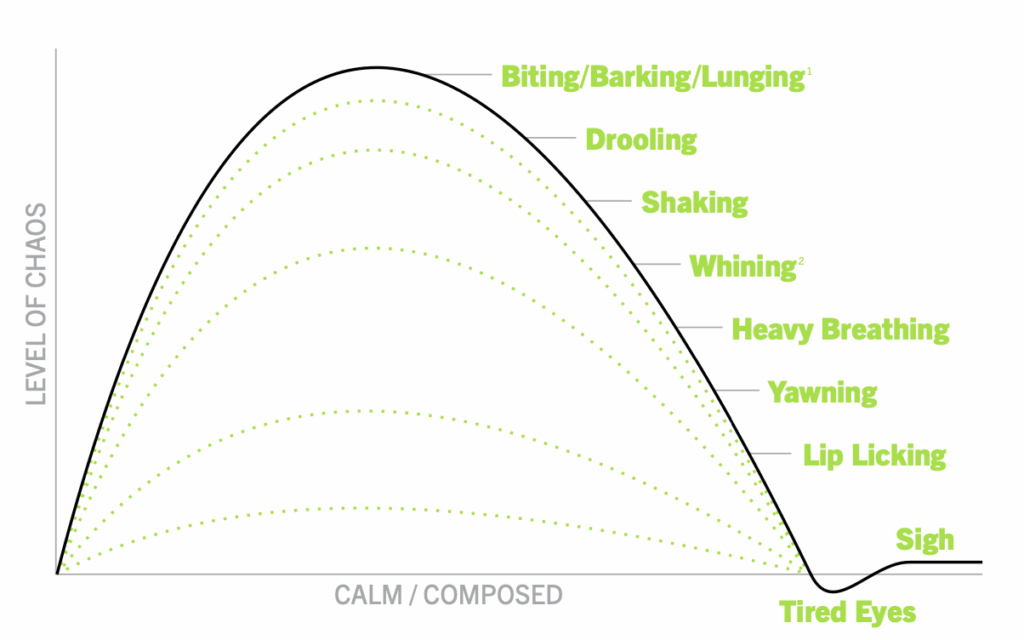Why Your Dog Gets Sick in the Car: A Trainers Point of View
As a human, or a dog, it is no fun getting sick in the car. As humans, it’s easier to recognize why, or when. But why does your dog get sick in the car?
Dog’s are more likely to get sick in the car if they are overstimulated, stressed, or excited. You’ve probably noticed panting, drooling or whining just before your dog gets sick in the car. This is because they are already stressed, and the unpredictable motion of the car and the extra stimulation throws them over the top and then your dog gets sick in the car.
What is the stress scale?
Let’s dig into some of the science. We know that dogs’ behavior is driven by adrenaline. We can monitor how adrenalized they are, on a scale. Dogs give obvious signs about their stress levels.
So if your dog is half way up the stress scale, is whining and maybe beginning to drool, they are already that much closer to losing the contents of their stomach. Then how do we teach them to be calm, instead of stressed? Socialization, or “composure training” as we like to call it.

Why Dogs Get sick in the Car:From a Vet’s Point of View:
Dr. Pamela Johnson is our go-to expert when it comes to animals. Whenever we have questions about a dog’s health, she’s the first person we trust. Here’s her insight on understanding and easing car sickness in dogs:
- Immature Inner Ear (Vestibular System): Puppies often experience car sickness because their balance system isn’t fully developed.
- Motion vs. Visual Mismatch: Their inner ear senses motion, but if they can’t see it clearly, the brain gets confused, leading to nausea.
- Anxiety & Stress: Negative associations with car rides (like going to the vet) can cause drooling, panting, and vomiting.
- Genetics & Sensitivity: Some dogs are naturally more prone, much like humans who are sensitive to motion sickness.
- Underlying Medical Issues: Ear infections, vestibular disease, or gastrointestinal issues can worsen or trigger car sickness.
- Poor Conditioning: If dogs only ride in the car for stressful events, they never develop positive associations. (See “Why your Dog gets sick in the car: From a Trainers Point of View”)

How to Stop Your Dog’s Carsickness with Behavior:
When most people think about “socializing” a puppy, they imagine exposing them to as many new people, dogs, and places as possible. While exposure is important, what really matters is how your dog responds in those moments. This is where composure training comes in.
Composure training is all about teaching your dog to stay calm and confident—even in distracting or stressful situations, like when your dog gets sick in the car. Instead of reacting with fear or overexcitement, your dog learns how to focus on you and regulate their energy.
What it Looks Like When Your Dog Gets Sick in the Car
A dog that is stressed in the car may look like:
- Whining incessantly
- Pacing in the back (or front, this is very dangerous!).
- Panting or heavy breathing.
- Drooling.
- Vomiting.
These are the main behavioral signs your dog is stressed while in the car. So if your dog gets sick in the car, how do we practice Composure training?
How to Practice Composure Training
Like any skill, composure is built with practice. Here are a few core areas to focus on:
1. Composure Inside the Home
Start inside the home. We know, there isn’t anything to create motion sickness inside. The best way to help your dog is by practicing calm in a non-stressful situation. Using a leash, help your dog practice a down command, and when something exciting happens (knocking on the door, dropping something loud behind them), help them stay there until they are calm again. A good sign to look for is that sigh. Practice this so they can stay in a down for an extended period of time so they learn to be more calm in general.
2. Composure Next to the Car
In the cool part of the day, practice a down command near your car. Bring a camp chair and a book to occupy yourself. Give your dog the down command and stay there for a while. Usually fifteen minutes minimum. If your dog gets out of the down command, use the leash to redirect them into the down command.
3. Composure In the Crate
Training when your dog gets sick in the car is less than fun. It requires a lot of clean up, and consistency. Utilizing the crate makes clean up a lot easier and it naturally helps your dog calm down. If your dog isn’t crate trained, start by crate training inside your home. Aim for two naps that are a few hours in length. Giving them a break from stimulation will help them naturally be more calm, and will make it easier to train when your dog gets sick in the car.
4. Composure in the Car
Many dogs experience car sickness because they build high anxiety around travel. Start small, and work your way up.
*Make sure you stay in the car with them, so you can monitor if it is too hot. Even 75 degrees outside can cause the interior to be well over 90 degrees.*
- Feed your dog a meal inside a parked car with the engine off. Only do this if you don’t plan on going anywhere with them.
- When that becomes normal, practice short fifteen minute sessions inside the crate(without food), in the car with the engine running but no driving. Watch their stress levels, listen for the sigh.
- Being in the crate in the car will be less stressful after a while. Then graduate to your dog crated in the car for fifteen minutes, then take a very short drive—just around the block—keeping excitement levels low. Park the car, wait with them in the car for another fifteen minutes or until you hear them sigh. Get them out, and reward.
The goal is to make the car a neutral, calm place, not a source of stress or adrenaline. Over time, your dog learns that car rides aren’t something to fear, which greatly reduces the risk of motion sickness.
Your Role in Composure Training
The most important part of composure training is your reaction. When your dog startles at a sound, resists a surface, or whines in the car, resist the urge to swoop in with comfort. Petting nervous behavior often reinforces it. Instead, redirect your dog’s focus with training, food, or calm leadership.
Think of it as building a “mental muscle.” Every time your dog practices calming themselves, that muscle grows stronger.
The Payoff
Composure training takes patience, but the rewards last a lifetime. A dog with composure is easier to live with, more enjoyable in public, and less prone to anxiety-driven behaviors.
At Cornerstone, we like to say: Focus kills chaos. When your dog learns to focus on you—even in the middle of distractions—they gain the confidence to face the world calmly. And you gain the peace of mind that your dog can handle life right by your side. Sign up for our courses to learn more.
Sometimes Dogs Get Sick in the Car, Even with Consistent Composure Training
“With gradual conditioning, positive experiences, and—if needed—medical support, most dogs can learn to travel comfortably. Be patient and consistent to help your pet overcome car sickness.” -Dr. Pamela Johnson
Before the Trip:
- Feed a small meal 3–4 hours before travel. Avoid big meals right before the ride.
- Make sure your dog is hydrated, but don’t give a huge amount of water right before the car.
- Give a short walk or play session before travel to reduce anxiety.
During the Trip:
- Use a well-ventilated crate, doggy seat belt, or harness to help stabilize them.
- Keep the car cool and crack a window for fresh air.
- Have your dog ride low in the car (like on the floor behind the front seats) to reduce motion.
- Take frequent breaks so they can reset and relax.
Comfort & Distraction:
- Bring a blanket or toy that smells like home.
- Play soft music or use calming aids (pheromone sprays, calming collars).
- Start with short, positive rides and gradually increase the distance.
Medical Options (with veterinary guidance):
- Ginger treats or chews may help mild nausea.
- With a vet’s guidance, certain motion sickness medications (like Dramamine) can be used.
- Prescription meds such as Cerenia (maropitant) are highly effective against nausea.
Want the latest tips and updates on your pet’s health? Stay in the know by signing up for Dr. Pamela Johnson’s weekly newsletter. Click here to sign up!
+ show Comments
- Hide Comments
add a comment